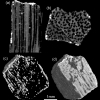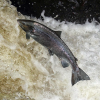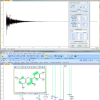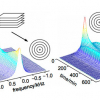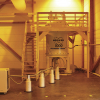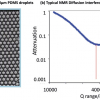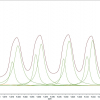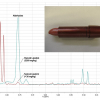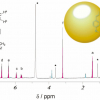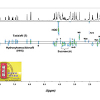Articles
Dates and fates of pyrogenic carbon: using spectroscopy to understand a “missing” global carbon sink
Research into climate change takes many directions, but storing carbon or understanding its release from stores is extremely important. Pyrogenic carbon comes from the incomplete burning of biomass, and can be natural, e.g. wild fires, or man-made, e.g. the production of charcoal. The authors describe the uses of a range of spectroscopy techniques to understand the molecular structure of pyrogenic carbon and its role in the global carbon cycle.
Fine sediments, often due to run-off from the land, can clog the surface and sub-surface spaces in gravel beds used by spawning fish to lay their eggs and by aquatic insects. Without an adequate flow of oxygenated water, the eggs and insects die. Heather Haynes, Susithra Lakshmanan, Anne-Marie Ockelford, Elisa Vignaga and William Holmes tells us about this in “The emerging use of magnetic resonance imaging to study river bed dynamics”. They have studied the infiltration of various sediments into model gravel beds both outside and flowing through a MRI instrument! They conclude that MRI “provides an exciting opportunity to unravel a plethora of processes relevant to wider environmental science”.
Tony Davies and Mohan Cashyap are concerned about your NMR data. When an article starts “On 10 October 2014 the impossible happened”, you will want to take note! Following the withdrawal of Agilent from the NMR business, Tony and Mohan consider three solutions to ensuring your NMR data is available now and into the future. If you have an NMR of any make, you will want to read this. Do remember that you can comment on the web version of the article.
“Rheo-nuclear magnetic resonance spectroscopy: a versatile toolbox to investigate rheological phenomena in complex fluids” is Claudia Schmidt’s topic. Rheology is an important science, and NMR has a number of uses within it. However, challenges remain for the simultaneous measurement of rheological and NMR parameters.
Mathieu Duval raises the question “Dating fossil teeth by electron paramagnetic resonance: how is that possible?”. Whilst we are all familiar with 14C dating, the use of EPR is less well known. In fact, there are less than 10 laboratories in the world able to carry out EPR dating of fossil teeth!
Tony (A.N.) Davies is getting excited by GHz NMR. These new high fields offer tantalising new areas of research but at a cost that generally requires their purchase by Government-funded centres of excellence. He argues that continued funding of such projects is essential, especially in difficult economic times.
Many analytical methods have been used to control the quality, authenticity and origin of fresh fruit. NMR methodologies yield a comprehensive metabolic profile, provide direct structural information regarding individual metabolites in the mixture and also give information regarding the water state in the tissue. This is useful in discriminating various fruits varieties, in investigating nutritional properties, in monitoring the development of the fruit and in assessing the optimum harvesting time.
Peter Jenks has discovered quantitative NMR. in his article titled “NMR: is it the future for the analysis of organic molecules?”. If only it wasn’t so expensive, it might be the perfect method to certify pure organic compounds.
Nuclear magnetic resonance (NMR) spectroscopy is one of the most powerful analytical tools used to probe details of molecular structure and dynamics. It requires very high magnetic fields and, hence, generally uses extremely large, powerful magnets. The advent of small, powerful magnets has allowed much less expensive low resolution NMR instrumentation to be designed, making it feasible to measure commercially important characteristics of dispersion behaviour and performance, including the wetted surface area of particulate suspensions and emulsion droplet size. An important additional practical application is the ability to determine competitive adsorption and/or displacement of polymers and surfactants at interfaces. This article presents a brief overview of these new approaches together with an example of each measurement.
1H NMR spectra are usually interpreted by hand, which is very time consuming, and can become a process bottleneck in fields such as high-throughput NMR. Greater automation of the spectral analysis process has become essential if NMR is to be of value as a high-throughput analytical method in the future.
Dirk Lachenmeier, Marina Gary, Yulia Monakhova, Thomas Kuballa and Gerd Mildau describe “Rapid NMR screening of total aldehydes to detect oxidative rancidity in vegetable oils and decorative cosmetics”. Lipid oxidation produces rancid products, which are both unpleasant and potentially toxic. The authors describe the use of NMR to screen food and cosmetic products. Whilst, vegetable oils were generally found to be in good condition, German women may wish to be careful of their lipstick, especially if they have had kept it for a while!
An NMR tour of Mediterranean anise-flavoured alcoholic beverages.
This article outlines the use of the DOSY NMR method applied to drug analysis and screening for counterfeit drugs or fake herbal medicines
A.N. Davies
External Professor, University of Glamorgan, UK, Director, ALIS Ltd, and ALIS GmbH – Analytical Laboratory Informatics Solutions
“The man who gets the most satisfactory results is not always the man with the most brilliant single mind, but rather the man who can best coordinate the brains and talents of his associates.”—W. Alton Jones
Peter A. Rinck
European Magnetic Resonance Forum (EMRF) Foundation, WTC, BP 255, F-06905 Sophia Antipolis Cedex, France
In 1946, two scientists in the United States, independently of each other, described a physicochemical phenomenon that was based upon the magnetic properties of certain nuclei in the periodic system. This was “nuclear magnetic resonance”, for short “NMR”. The two scientists, Felix Bloch and Edward M. Purcell were awarded the Nobel Prize in Physics in 1952.
The purpose of this short review article is to highlight some capabilities of qNMR spectroscopic methods in drug quality evaluation, indicating that qNMR spectroscopy should be more often applied when chromatographic methods are not working effectively.
Our focus here is analytical procedures and the role of nuclear magnetic resonance (NMR) in particular. These have, until now, largely relied on conventional chromatography, and vibrational spectroscopy—infrared (IR), Raman and near infrared (NIR) spectroscopy. In spite of inherent difficulties with peak assignment and reliable quantification, vibrational spectroscopy has been used to derive information on reaction progression to impart fundamental understanding. This article sets out a wider scope to show how NMR can play a key role. Furthermore, NMR integrates well with established procedures to provide a suite of useful technologies that make the PAT challenge tractable.
Helen Williams and Mike Claybourn
AstraZeneca, Silk Road Business Park, Macclesfield, Cheshire, SK10 2NA, UK
Raymond J. Abraham and Mehdi Mobli
Chemistry Department, The University of Liverpool, PO Box 147, Liverpool L69 3BX, UK
Steve Down
HD Science Limited, 16 Petworth Avenue, Toton, Nottingham NG9 6JF, UK

